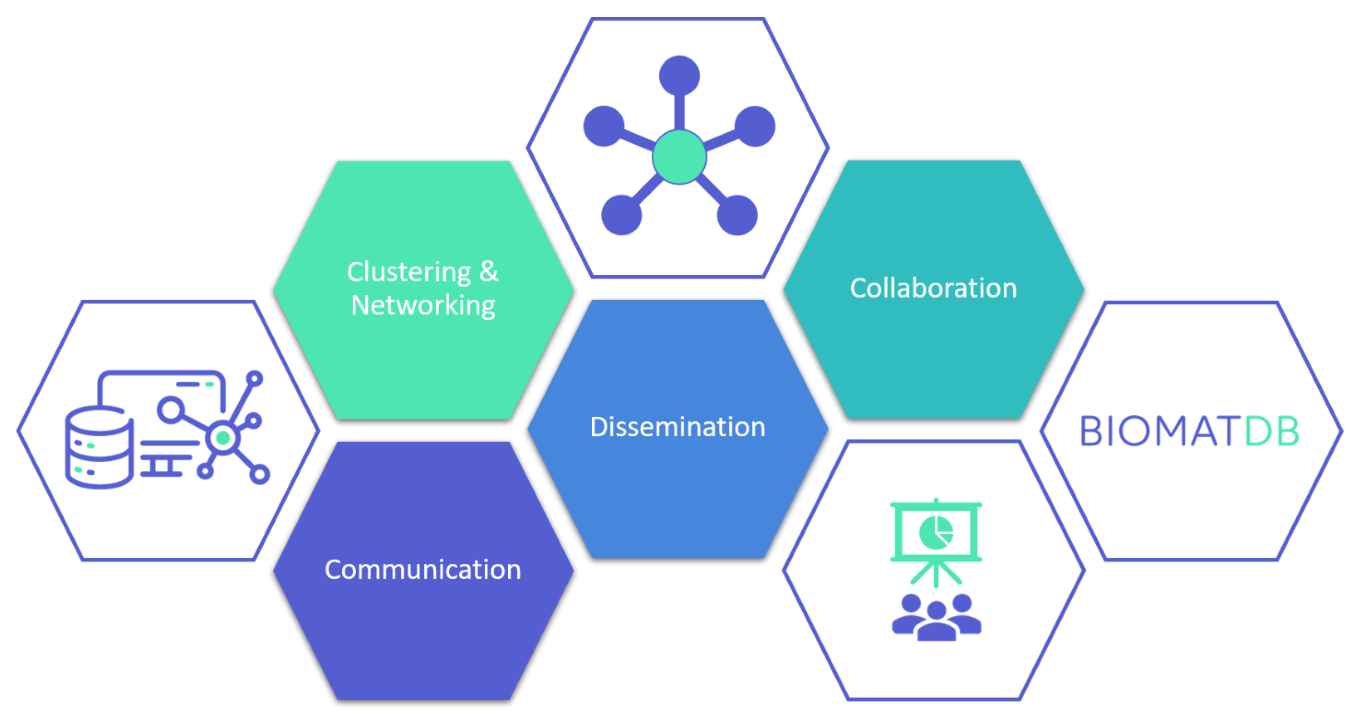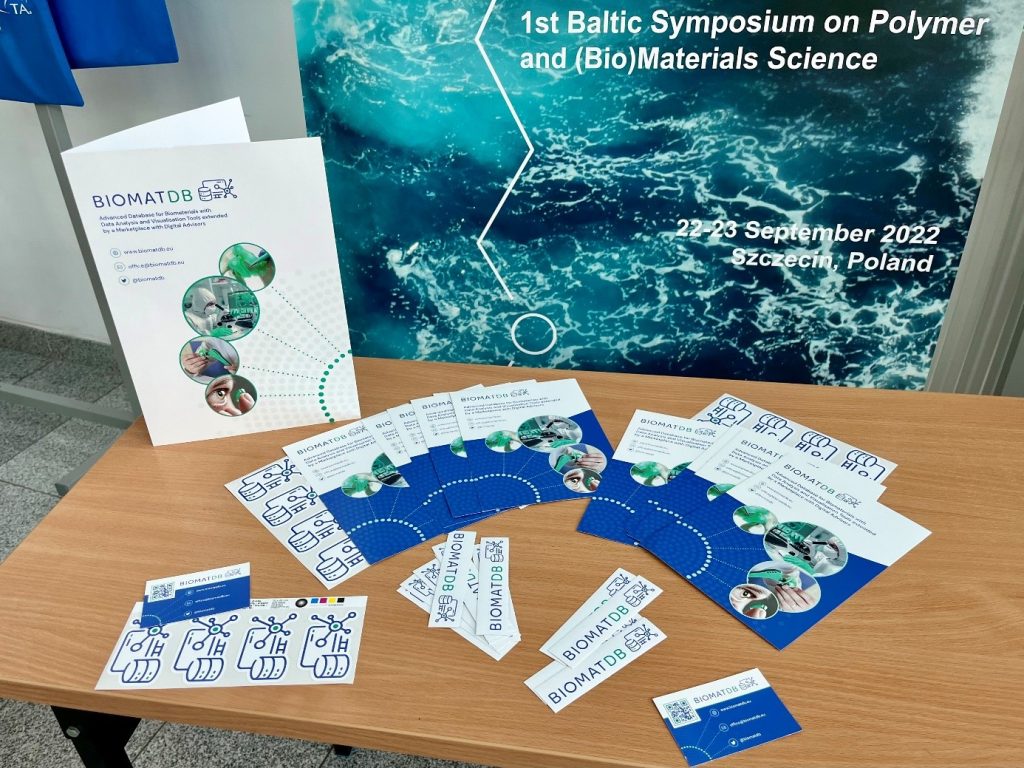
How BIOMATDB will ensure maximum impact of the project results
The establishment of a biomaterials database and marketplace is an important contribution to the biomaterials community. Yet creating the tools alone is not sufficient – only when the community knows that the database and the marketplace exist and why they should use these applications can the BIOMATDB solutions truly make an impact.
The magic words: Communication and Dissemination
As BIOMATDB is a project funded through the European Commission’s framework programme Horizon Europe, an essential aspect of the project is to make sure the general public as well as all relevant audiences are being reached and informed about the consortium’s activities and project outcomes.
In order to achieve this, BIOMATDB places great emphasis on the communication and dissemination activities of the project. To this end, the consortium is constantly engaging in different actions to ensure proper information of all relevant target groups.
As part of the communication activities, we raise awareness about the BIOMATDB project to the general public. This will make sure that we generate demand for these tools, communicate to a broad public how the biomaterials database and marketplace will benefit society, as well as show European citizens that public money is spent in a meaningful and valuable way.
Through our dissemination activities, we make sure that we reach all stakeholders who can actually profit from using the BIOMATDB solutions or who might be interested in the BIOMATDB results and knowledge. We identified these stakeholders at the very beginning of the project in order to be able to develop a targeted strategy and messages to reach them in the best possible way.
Who are our stakeholders?
At the beginning of the project, the BIOMATDB consortium defined the five stakeholder groups that are most relevant to the project and will be specifically targeted through the communication and dissemination activities. These groups include the following:
- Academia, research institutions, scientific communities (“Researchers”): This group includes people working within the research community in areas such as biomaterials or biomedical engineering. They are potential end users of the project’s solutions, especially the biomaterials database, which will be an especially useful tool for research.
- SMEs, start-ups, industry (“Suppliers”): This group includes suppliers of biomaterials or biomaterial-based medical devices, especially SMEs. They will be able to benefit from the developed biomaterials marketplace as it will facilitate market access and allow them to provide detailed information on their products.
- Medical/hospital organisations, health professionals and medical procurers (“Demanders”): This group can greatly benefit from the BIOMATDB solutions as an information source to support informed decisions in the purchase of biomaterials or biomaterial-based medical devices. This will especially be supported through the digital advisors that will be implemented on the biomaterials marketplace.
- Governmental/policy stakeholders, public bodies, investors (“Policy makers & investors”): This group includes people working in policy making or investment in the area of biomaterials or related fields. These groups are highly relevant for fostering the harmonisation of the biomaterials’ domain as part of the European healthcare system.
- Societies, associations, networks or foundations in the context of biomaterials (“Enablers”): These groups are highly relevant to the BIOMATDB project as they can facilitate valuable connections to all other stakeholder groups and thereby ensure a higher exploitation of the developed solutions.
How are we communicating and disseminating the project’s progress and results?
In order to reach as many stakeholders as possible, the BIOMATDB consortium uses a multi-channel dissemination approach. The main dissemination channels utilized are the following:
- Social media: On the BIOMATDB Twitter and LinkedIn channels, the general public and stakeholders are regularly informed about the project’s progress, attendance at events, the latest results, and other related news. Furthermore, the social media platforms allow direct interactions between the consortium and interested people through comments and private messaging functions.
- Newsletter: At least twice a year, a newsletter is sent out that aims to give an overview of all recent progress in the project as well as opportunities for stakeholder engagement and other interesting news.
- Project website: With news articles such as this one, the consortium aims to inform stakeholders about interesting developments in the field of biomaterials, outputs of the project, activities of the partners, or other developments. Additionally, the events listing on the website gives an overview of relevant events in the field of biomaterials. The project website further provides all relevant information about the BIOMATDB project, such as its objectives, its methodology and the consortium.
- Events: Consortium partners regularly participate in events in the field, such as the BIOnTEQ Event in Portugal or the 1st Baltic Symposium on Polymer and (Bio)Materials Science in Poland. There, partners inform local stakeholders about the project and our activities. Information on past and upcoming event attendance of the BIOMATDB partners is being published on the project’s social media channels.

Dissemination materials and a uniform design concept
A central element of our dissemination and communication strategy are the virtual and physical dissemination materials which are designed according to the uniform BIOMATDB design concept. These materials can be used at any time by our consortium members to promote the BIOMATDB project and to present the project at events (see also Figure 1). Virtual materials include logos and banners that can be used for our social media channels, website and newsletters. Physical materials include business cards, leaflets, roll-ups and stickers. Through the fixed visual identity, new materials can be designed as needed, like, for example, when we need materials to disseminate our surveys.
Collaborations with other projects
Another important focus of the BIOMATDB dissemination activities is clustering with other related projects. Establishing collaborations with other projects in the field can have many benefits, such as facilitated exchange of knowledge, benefitting from each other’s results, and enlarging stakeholder networks. To this end, BIOMATDB has already been in contact with several projects and will continue to establish such collaborations.
Examples for projects contacted for collaboration include:
- OntoCommons: The OntoCommons project is a H2020-funded project dedicated to the standardisation of data documentation across all domains related to materials and manufacturing.
- Safe-N-MedTech: The Safe-N-MedTech project is developing an innovative open access platform to offer companies and reference laboratories the opportunity for developing, testing, assessing, upscaling and marketing nanotechnology-based medical and diagnosis devices.
The Horizon Results Booster
BIOMATDB has recently started receiving support from the Horizon Results Booster. The Horizon Results Booster (HRB) is a service funded by the European Commission aiming to support EU-funded projects with their dissemination, exploitation and communication activities. They offer different modules delivering various outputs such as, for example, a joint dissemination plan of a project group, fact sheets, video pills, webinars, and more. BIOMATDB is currently receiving support in the area of clustering and is now in the process of forming a project group with related projects that will be able to benefit from each other’s results. Updates on this project group will be published on the project’s social media channels as well as on the project website.
Ensuring the impact of the BIOMATDB project beyond the project’s duration
It is crucial that the BIOMATDB solutions do not fade away with the end of the project. The BIOMATDB solutions should bring sustainable benefits to the biomaterials community, the medical device sector, the European economy and society in general. The intensive communication and dissemination as well as the expansion of our networks through collaborations is therefore essential so that the database and the marketplace, once they are launched, can count on great interest and a broad user base.
Furthermore, the knowledge gained during the project should be available to the community and subsequent projects should be able to build on it. Therefore, if you are part of the biomaterial community, take a look at the peer-reviewed open access scientific articles that have already been implemented through BIOMATDB funding after you have finished reading this article:
- Haugen, H.J., Schneider, A., Schlicht, H. et al. Long-Term In Vivo Response of a Polyurethane Gastric Implant for Treating Gastro-Oesophageal Reflux Diseases: A Comparison of Different Surface Treatments. Biomedical Materials & Devices (2022). https://doi.org/10.1007/s44174-022-00055-8
- Munir, A.; Marovic, D.; Nogueira, L.P.; Simm, R.; Naemi, A.-O.; Landrø, S.M.; Helgerud, M.; Zheng, K.; Par, M.; Tauböck, T.T.; Attin, T.; Tarle, Z.; Boccaccini, A.R.; Haugen, H.J. Using Copper-Doped Mesoporous Bioactive Glass Nanospheres to Impart Anti-Bacterial Properties to Dental Composites. Pharmaceutics2022, 14, 2241. https://doi.org/10.3390/pharmaceutics14102241
Authors: Violeta Heinze, Celine Rabé
Keywords
Dissemination, exploitation, communication, clustering, project, networking, stakeholders, collaboration